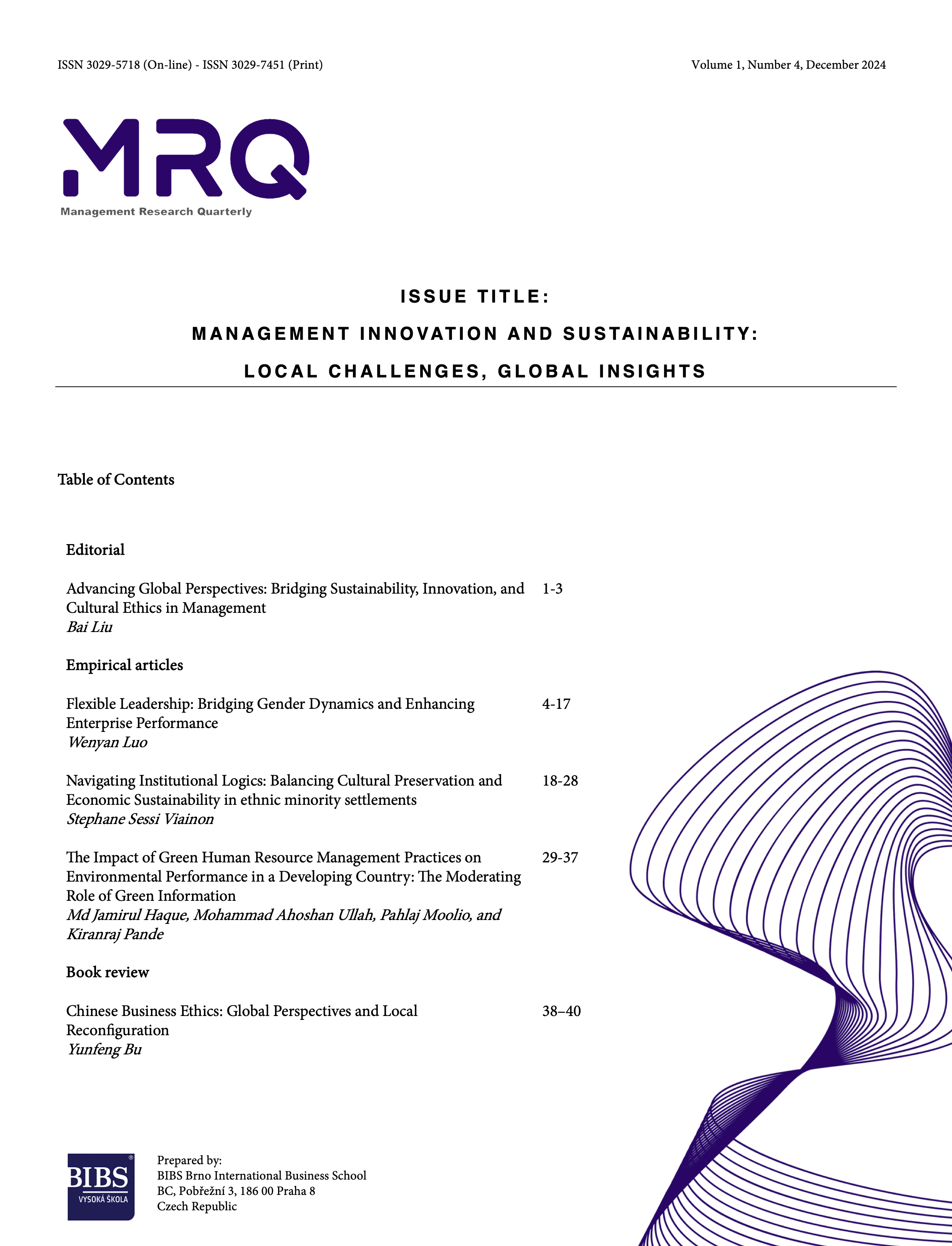The Impact of Green Human Resource Management Practices on Environmental Performance: The Moderating Role of Green Information Management Systems in Cambodian Manufacturing Firms
Published 2025-01-17 — Updated on 2025-02-22
Versions
- 2025-02-22 (2)
- 2025-01-17 (1)
Copyright (c) 2025 Management Research Quarterly

This work is licensed under a Creative Commons Attribution-NonCommercial-NoDerivatives 4.0 International License.
How to Cite
Abstract
This study will investigate the relationship between the implementation of GHRM practices and its impact on EP in medium to large-scale manufacturing firms in Cambodia, with GIMS as a moderating variable. The design of the present study was a cross-sectional survey that gathered responses from 217 managers from firms practicing GHRM. A culturally adapted and validated questionnaire was used. SEM analysis indicated significant associations among GHRM, GIMS, and EP. Results also indicate that GHRM practices improve not only environmental performance but also sustainability culture. The contribution of this study is that it adds to the literature on green organizational practices and provides various insights to managers and policymakers on the integration of environmental sustainability into business strategy.
References
- Hofstede, G. (2001). Culture's consequences: Comparing values, behaviors, institutions, and organizations across nations (2nd ed.). SAGE Publications.
- Trompenaars, F., & Hampden-Turner, C. (1997). Riding the waves of culture: Understanding diversity in global business (2nd ed.). McGraw-Hill.
- House, R. J., Hanges, P. J., Javidan, M., Dorfman, P. W., & Gupta, V. (2004). Culture, leadership, and organizations: The GLOBE study of 62 societies. SAGE Publications.
- Triandis, H. C. (1995). Individualism and collectivism. Westview Press.
- Schwartz, S. H. (1994). Are there universal aspects in the structure and contents of human values? Journal of Social Issues, 50(4), 19–45. https://doi.org/10.1111/j.1540-4560.1994.tb01196.x
- Ting-Toomey, S. (1999). Communicating across cultures. Guilford Press.
- Matsumoto, D., & Juang, L. (2016). Culture and psychology (6th ed.). Cengage Learning.
- Hofstede Insights. (n.d.). Country comparison tool. Retrieved from https://www.hofstede-insights.com/product/compare-countries/
- Hall, E. T. (1989). Beyond culture. Anchor Books.
- Chea, C., & Sok, P. (2020). Influence of cultural dimensions on leadership practices in Cambodian organizations. Journal of Cambodian Studies, 15(2), 45–60.
- Sovann, R. (2022). Cultural challenges in Cambodian workplaces: A review of emerging themes. Asian Journal of Management and Development, 9(1), 89–102.
- Yin, R. K. (2018). Case study research and applications: Design and methods (6th ed.). SAGE Publications.
- Geertz, C. (1973). The interpretation of cultures: Selected essays. Basic Books.
- World Bank. (2021). Overview: Cambodia. Retrieved from https://www.worldbank.org/en/country/cambodia/overview
- UNDP. (2022). Human development report 2022: Cambodia. Retrieved from https://hdr.undp.org/countries/profiles/KHM
- Brislin, R. W. (1986). The wording and translation of research instruments. In W. J. Lonner & J. W. Berry (Eds.), Field Methods in Cross-Cultural Research (pp. 137–164). Sage Publications.
- Dangelico, R. M., & Pontrandolfo, P. (2015). Being ‘green and competitive’: The impact of environmental actions and collaborations on firm performance. Business Strategy and the Environment, 24(6), 413–430. https://doi.org/10.1002/bse.1828
- Dubey, R., Gunasekaran, A., Childe, S. J., Wamba, S. F., & Papadopoulos, T. (2017). The impact of big data on world-class sustainable manufacturing. The International Journal of Advanced Manufacturing Technology, 84(1), 631–645. https://doi.org/10.1007/s00170-015-7674-1
- Jabbour, C. J. C., & de Sousa Jabbour, A. B. L. (2016). Green Human Resource Management and green supply chain management: Linking two emerging agendas. Journal of Cleaner Production, 112, 1824–1833. https://doi.org/10.1016/j.jclepro.2015.01.052
- Luthra, S., Garg, D., & Haleem, A. (2016). The impacts of critical success factors for implementing green supply chain management towards sustainability: An empirical investigation of Indian automobile industry. Journal of Cleaner Production, 121, 142–158. https://doi.org/10.1016/j.jclepro.2016.01.095
- Rahman, N. H. A., & Bakar, M. S. A. (2019). The impact of manufacturing industries on economic growth: Evidence from ASEAN countries. International Journal of Supply Chain Management, 8(3), 1370–1378.
- Renwick, D. W. S., Redman, T., & Maguire, S. (2013). Green Human Resource Management: A review and research agenda. International Journal of Management Reviews, 15(1), 1–14. https://doi.org/10.1111/j.1468-2370.2011.00328.x
- Zhu, Q., Sarkis, J., & Lai, K.-H. (2008). Green supply chain management implications for “closing the loop.” Transportation Research Part E: Logistics and Transportation Review, 44(1), 1–18. https://doi.org/10.1016/j.tre.2006.06.003





